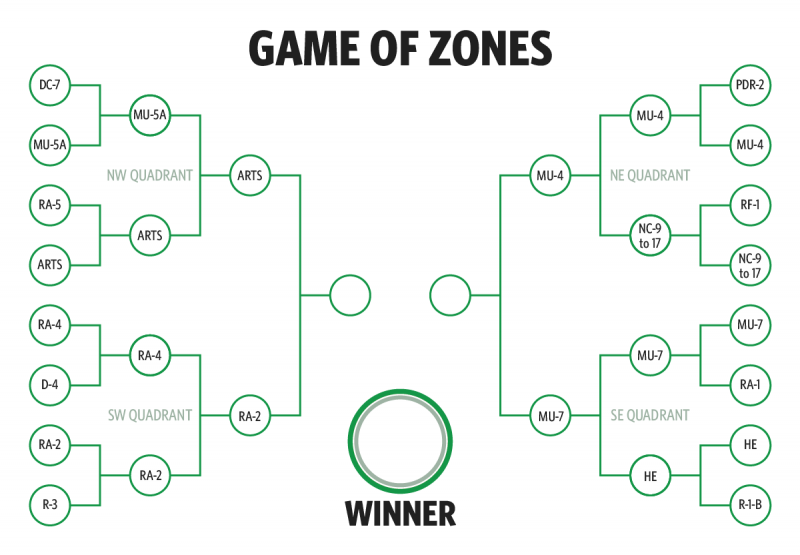In Game of Zones, we’re down to the Final FAR

Image by Peter Dovak used with permission.
Zoning laws shape the buildings that surround us, leaving some land with tall office buildings and other places with only single-family houses. But they also seem mysterious to many people.
Since March is mad for tournaments, we've teamed up with the DC Office of Zoning to devise Game of Zones: a fun way to learn about zoning districts that shape neighborhoods across the DC. Read up in their Zoning Guidebook about what makes each zone special, vote for your favorites, and root for your team in the comments!
Round Four brings us to the Final FAR (as in Floor Area Ratio or a building's total floor area divided by the amount of space it sits in), with one finalist representing each of the District's four quadrants. One of our Round Three races was decided by just three votes, so your vote definitely counts!
The games were called as of 3 PM on Wednesday. You can review the earlier posts to see who was eliminated in the Northwest, Southwest, Northeast, or Southeast quadrants.
Northwest vs. Southwest
ARTS vs. RA-2
Image by District of Columbia Office of Zoning used with permission.
On the west side of town, it's a choice between nightlife and bedtime. The four ARTS zones, found around the bustling intersection of 14th and U Streets NW are similar to the MU-4, MU-5, MU-7, and MU-10 zones, but with additional rules. Customized zoning districts like ARTS can get cumbersome; e.g., the ARTS districts strictly limit restaurants and bars, which leads to strange situations like basement bars below bank branches.
Image by District of Columbia Office of Zoning used with permission.
RA-2 just squeaked past its high-rise neighbor RA-4 to make this round. It's the only (mostly) single-use zone that made it into the semi-finals, but it's literally a popular one. Its rowhouses and walk-up apartments provide the low-rise, high-density population that surrounds Adams Morgan and Howard University. 3-story apartments like those in RA-2 are ubiquitous in Boston, Brooklyn, Chicago, and Montreal, but less so in DC.
Vote for one!
Northeast vs. Southeast
MU-4 vs. MU-7
Image by District of Columbia Office of Zoning used with permission.
It's a match of Mixed Use vs. Mixed Use on the east side of town, but at two rather different densities. MU-4 permits up to four floors of mixed-use; it's found along “streetcar suburb” main streets like Kennedy and Mount Pleasant streets, and long stretches of Florida, Georgia, Rhode Island, and Wisconsin avenues. Its low scale works in tourist-filled Georgetown, but elsewhere many MU-4 streets struggle to attract businesses and customers.
Image by District of Columbia Office of Zoning used with permission.
MU-7 allows 60% bigger buildings than MU-4, and is more selectively applied around major transit hubs. That density allows large-scale retail like DC USA and Mazza Gallerie, or lower-scale retail with more residential above as around the Van Ness Metro. It's also been applied to a few sites where redevelopment is anticipated, like the Forman Mills strip mall in Edgewood, Skyland, Minnesota-Benning, and MLK Avenue in Historic Anacostia.
Vote for one!
Thanks for playing so far. Come back early next week to vote on the finalists in Game of Zones!
